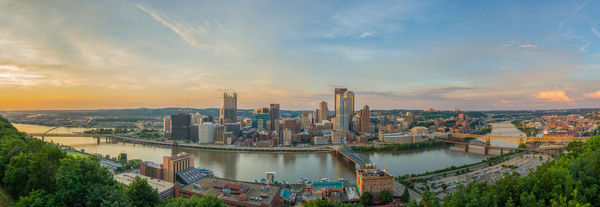Journalists are eligible for free email subscriptions to SEJournal, including TipSheet, WatchDog (on access issues) and more.
#SEJ2017
| Agenda | Coverage | Lodging/ Travel | Advertisers/ Exhibitors | Environmental News | About Pittsburgh |
It’s been 13 years since the Society of Environmental Journalists last encamped in “The Paris of Appalachia,” near the confluence of the Allegheny and Monongahela rivers, where the mighty Ohio River begins. Much has happened, here, across the nation and in Washington, D.C. And at SEJ’s 27th annual conference — what we’ve dubbed the “Rivers of Change” gathering — we’re going to paddle through a lot of it.
Hosted and sponsored by The University of Pittsburgh/Swanson School of Engineering, the conference will blend a local, post-industrial focus on the Pittsburgh region with a strong current of national and global environmental issues. And this year we’ll place added emphasis on environmental justice, with an opening plenary at the August Wilson Center for African American Culture and a complementary track that spans the conference. Another strong track will focus on practical craft sessions that explore data and investigative journalism, your legal rights when reporting, safety in the field and more.
Additional sessions will address the convergence of science, policy, politics and social media, and how that mash-up has muddied our jobs as journalists covering the environment. We’ll assess the evolving mainstream media, the roiling freelance landscape and advocacy journalism against a background of “alternative facts” that has made our professional navigation both more difficult and daunting, but ever more crucial.
In southwestern Pennsylvania, Old King Coal has been dethroned by its fossil fuel friend shale gas, igniting a boom that began a decade ago, went bust due to overproduction and now promises to mount something of a comeback. We’ll do our best to get you on a pad and to the construction site of the first “cracker” plant outside of the South. And on that tour, we will certainly get you in touch with public-health professionals, residents of the drilling fields and activists who will raise important health and environmental justice issues.
Other tours will take conference attendees to the Allegheny National Forest, where battles rage over gas-well drilling and invasive species; Laurel Caverns, for an update on white-nose syndrome, a fungus wiping out bats; and the Flight 93 Memorial and Fallingwater, exemplars of environmental design — possibly just in time for Fallingwater to be dubbed the first U.S. World Heritage Site for modern architecture. Another group will head to the Mon (that’s short for Monongahela) Valley, the one-time industrial heart of the nation, where the steel was made that won world wars, built famous bridges and spurred the United States’ growth into a superpower.
The Mon Valley is also where we’ll hold our spectacular Saturday night party, this year on Friday (there’s a good reason, trust us), at the 110-year-old Carrie Furnaces, rusty, iconic, industrial iron furnaces that are part of the Rivers of Steel National Heritage Area. We’ve invited John Kerry to speak about the Paris Climate Accord and how it will fare under the Trump administration, an event we’re billing as “Kerry @ Carrie.”
Our Sunday breakfast, at the spectacularly green Phipps Conservatory and Botanical Gardens, will have a presidential focus. Douglas Brinkley, who authored exhaustive environmental biographies of Teddy Roosevelt and his distant cousin Franklin Delano Roosevelt, has been invited, as has Theodore Roosevelt IV, a banker-conservationist who has worked with Native American tribes to stop mining in the Chugach National Forest. We’ve also invited Interior Secretary Ryan Zinke, who has billed himself as a conservationist in Teddy’s mold. We’ll see.
So come for the conference and stay for the post-conference tour, which this year will be a four-day, three-night cycle on a section of the Great Allegheny Passage, the 150-mile, rails-to-trails bike path that stretches from Pittsburgh to Cumberland, Maryland, through some of the most scenic parts of western Pennsylvania’s Laurel Highlands.
You do not want to miss this one. If you do you’ll feel worse than a White House reporter who didn’t get invited to a Spicer office gaggle.
Consider yourself invited. We hope you can join us.
Conference Chairs:
Jennifer Bogo, Deputy Editor, Audubon
Don Hopey, Environment Reporter, Pittsburgh Post-Gazette
 |
| Taken from Mt. Washington, the rivers hug the Golden Triangle of downtown. © Dave DiCello |
About The University of Pittsburgh
The University of Pittsburgh, established in 1787, is one of the oldest American institutions of higher learning and ranked Best Public University in the Northeast by The Wall Street Journal. The University system of 16 Pittsburgh Campus schools and four regional campuses offers over 470 degree programs, a world-renowned medical center and more than 300 research centers, institutes, laboratories and clinics serving 35,000 students. Pitt ranks in the top 10 in federal science and engineering funding, according to a report from the National Science Foundation, and fifth among U.S. universities in competitive grants awarded to faculty by the National Institutes of Health. Pitt faculty have pioneered major medical advances including the Salk polio vaccine, multiple-organ transplantation, CPR and breast cancer treatment, while its alumni have won the Nobel Peace Prize, the Nobel Prize in Medicine, the Pulitzer Prize, the National Medal of Science, Olympic gold medals, Academy Awards and Super Bowl championships.















 Advertisement
Advertisement 



